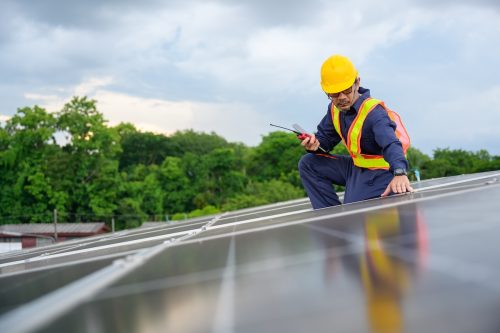It might seem that persistently high unemployment rates over the past few years have rendered moot the debate over whether or not the United States really “needs” the highly skilled foreign workers who come here on H-1B temporary visas. But the demand for H-1B workers still far outstrips the current cap of only 65,000 new H-1B visas that can be issued each year. In fact, from fiscal year 1997 to 2011, employers exhausted this quota before the fiscal year was over (except from 2001 to 2003, when the ceiling was temporarily increased). As a number of studies make clear, the presence in a company of highly skilled foreign workers whose abilities and talents complement those of native-born workers actually creates new employment opportunities for American workers. Yet the arbitrary numerical limits placed on H-1Bs are incapable of responding to the changing demand for H-1B workers. This is unfortunate, given that the international competitiveness of the U.S. economy will continue to depend heavily on the contributions of H-1B professionals and other high-skilled workers from abroad for many decades to come.
Foreign-born scientists and engineers fuel U.S. innovation and job creation.
- A December 2008 study released by the Harvard Business School found that immigrants comprise nearly half of all scientists and engineers in the United States who have a doctorate, and accounted for 67 percent of the increase in the U.S. science and engineering workforce between 1995 and 2006.
- According to the study, the H-1B visa program for highly skilled foreign professionals “has played an important role in U.S. innovation patterns” over the past 15 years. This is evidenced by the fact that the number of inventions, as measured by patents, has increased when H-1B caps are higher due to “the direct contributions of immigrant inventors.”
- As New York Times op-ed columnist Thomas L. Friedman asked in a column on February 10, 2009, “in an age when attracting the first-round intellectual draft choices from around the world is the most important competitive advantage a knowledge economy can have, why would we add barriers against such brainpower—anywhere?”
- A 2009 study from the Technology Policy Institute found that, in the absence of H-1B and green-card limitations from 2003-2007, foreign graduates of U.S. universities in science, technology, engineering, and math fields would have raised the Gross Domestic Product (GDP) by about $13.6 billion in 2008, and contributed $2.7 to $3.6 billion in taxes.
H-1B workers are associated with job creation.
- In a study released in March 2008, H-1B Visas and Job Creation, the National Foundation for American Policy (NFAP) found that, among technology companies in the Standard & Poor’s (S&P) 500, there is “a positive and statistically significant association” between the number of H-1B positions requested by employers between 2001 and 2005, and the percentage change in total employment of those employers one year later.
- In 2008, Bill Gates testified that “Microsoft has found that for every H-1B hire we make, we add on average four additional employees to support them in various capacities.”
- According to the NFAP, “for every H-1B position requested, U.S. technology companies increase their employment by 5 workers,” on average, the following year. For technology companies with fewer than 5,000 employees, “each H-1B position requested in labor condition applications was associated with an increase of employment of 7.5 workers.”
- This suggests that the U.S. labor market’s demand for H-1B workers expands and contracts with the demand for highly skilled workers in general. It also suggest that the presence in a company of highly skilled foreign workers—whose abilities and talents complement, rather than substitute for, those of native-born workers—creates new employment opportunities American workers.
- In a survey of 120 technology companies, the NFAP also found that 65 percent had reacted to the arbitrarily low limits on the hiring of foreign nationals through the H-1B program by moving more of their work out of the United States—to countries where the workers they need are available.
- A similar survey by the Government Accountability Office (GAO) found that companies which were denied H-1B workers sometimes placed their job candidates temporarily overseas. More than a quarter of research and development centers surveyed stated that the H-1B cap was an “important determinant in the creation of these overseas centers.”
H-1B workers don’t “steal” jobs from U.S. workers.
- H-1B visas are issued to temporary, “nonimmigrant” workers in “specialty occupations.” As described by the Congressional Research Service, a “specialty occupation” is one “requiring theoretical and practical application of a body of highly specialized knowledge in a field of human endeavor including, but not limited to, architecture, engineering, mathematics, physical sciences, social sciences, medicine and health, education, law, accounting, business specialties, theology, and the arts, and requiring the attainment of a bachelor’s degree or its equivalent as a minimum.”
- Under the H-1B program, the U.S. Department of Labor (DOL) is tasked with ensuring that H-1B workers “do not displace or adversely affect wages or working conditions of U.S. workers.” To this end, each employer seeking to hire an H-1B worker is required to file a Labor Condition Application (LCA) with DOL in which “the employer must attest that the firm will pay the nonimmigrant the greater of the actual compensation paid other employees in the same job or the prevailing compensation for that occupation; the firm will provide working conditions for the nonimmigrant that do not cause the working conditions of the other employees to be adversely affected; and that there is no applicable strike or lockout.”
- If DOL certifies the employer’s LCA, the employer can file a petition with U.S. Citizenship and Immigration Services on behalf of a potential H-1B worker, who must demonstrate that he or she has “the requisite education and work experience” for the job. If approved, the H-1B worker is authorized to work for the U.S. employer for up three years, with one renewal allowed, for a maximum stay of six years.
H-1B workers are not “cheap labor.”
- A 2011 report by the GAO found that, once adjusted for age, H-1B workers in most occupations earn the same or more than similar U.S. workers. In addition, the report found that companies hiring H-1B workers incurred significant expenses in fees and legal costs to hire these workers, all of which indicates that companies are hiring the best candidate for the job, not the cheapest one.
- The NFAP points out that employers are required not only to pay an H-1B employee the higher of either the “prevailing wage” or “actual wage” paid to similarly employed Americans, but must also pay about $6,000 in legal and government fees for each H-1B hire, plus up to $12,000 more to sponsor an H-1B worker for permanent residence in the United States.
- The NFAP also points out that use of H-1B visas by employers varies according to the demand for skilled workers in general. For instance, Congress raised the H-1B cap to 195,000 per year for Fiscal Year (FY) 2002 and FY 2003, but employers used only 79,100 and 78,000 in each of these years, respectively, when U.S. economic conditions worsened and labor demand declined. If H-1B workers were being used as “cheap labor,” as some critics allege, then one would expect employers to hire as many as possible during economic hard times in order to reduce labor costs. In fact, “H-1B filings at U.S. technology companies declined when companies were losing money or hit hard times.”
The U.S. economy needs high-skilled workers in a wide range of occupations.
- According to the National Science Board (NSB), the science and engineering (S&E) “labor force does not include just those in S&E occupations.” In Science and Engineering Indicators 2008, the NSB reports that “about 12.9 million workers said in 2003 that they needed at least a bachelor’s degree level of knowledge” in a science and engineering field to do their jobs. However, only 4.9 million of these workers were in occupations formally defined as belonging to a “science and engineering” (S&E) field.
- Moreover, 66 percent of “S&E degree holders in non-S&E occupations say their job is related to their degree, including many in management and marketing occupations.”
The economic value of high-skilled workers cannot be easily quantified.
- The NSB emphasizes that the value of highly skilled S&E workers from different parts of the world cannot be measured in simple, numerical terms given that science is, by its very nature, “a global enterprise” dependent upon the exchange of ideas from a diverse range of perspectives.
- According to the NSB, “new ways of doing business and performing R&D [research and development] take advantage of gains from new knowledge discovered anywhere, from increases in foreign economic development, and from expanding international migration of highly trained scientists and engineers.”
As our population ages and shrinks, highly skilled foreign professionals will become increasingly important to the U.S. economy.
- According to a 2007 study by Jacob Funk Kirkegaard of the Peterson Institute of International Economics, the skill levels of U.S. workers are stagnating relative to the rest of the world. As a result, “when American baby boomers retire, they will take as many skills with them as their children will bring into the U.S. workforce.” According to Kirkegaard, these demographic trends—combined with the growing international competition for skilled workers—suggest that “in the coming decade, America could face broad and substantial skill shortages.”
- Kirkegaard says that to overcome these challenges, the United States will not only have to implement new educational policies to produce more high-skilled Americans, but also “reform its high-skilled immigration policies and procedures not only to welcome the best and the brightest but also to make it easier for them to stay.” He finds that the need for reform is particularly urgent in “the H-1B temporary work visa and legal permanent resident (green card) programs.”
- Similarly, the National Science Board concludes that, “barring large reductions in retirement rates, the total number of retirements among workers with S&E degrees will dramatically increase over the next 20 years.” This suggests “a slower-growing and older S&E labor force”—a situation that would worsen “if either new degree production were to drop or immigration to slow.”
American companies support American students and workers through fees, taxes, and charitable contributions.
- As the NFAP points out in a May 2007 study, the American Competitiveness and Workforce Improvement Act of 1998 created a training-and-scholarship fee of $500 that U.S. companies hiring H-1B workers must pay for every new H-1B application and every first-time renewal of a worker’s H-1B status. This fee was raised by Congress to $1,000 in 2000. The fee was raised again, to $1,500, by the L-1 Visa and H-1B Visa Reform Act of 2004, which also mandated that 50 percent of the revenue from the fee go to National Science Foundation scholarships for U.S. undergraduate and graduate students in science and math, 30 percent to Department of Labor training programs for U.S. workers, and 10 percent to the National Science Foundation for K-12 math and science programs (plus 5 percent each to the Departments of Labor and Homeland Security for processing costs).
- According to the NFAP, the H-1B fees paid by U.S. companies since 1999 total more than $2 billion and “have funded more than 53,000 scholarships for U.S. students in math and science through the National Science Foundation, as well as hands-on science programs for 190,000 elementary, middle and high school students and 6,800 teachers. More than 55,000 U.S. workers have received training through the H-1B fees paid by companies.”
- In addition, U.S. businesses as a whole “pay over $91 billion a year in state and local taxes directed toward public education.”
- Companies that rely upon H-1B workers also make substantial charitable contributions that improve the math and science skills of U.S. students. The NFAP notes, for instance, that the Bill and Melinda Gates Foundation “has spent more than $3 billion since its inception on grants to improve education in the United States, with an emphasis on scholarships, science education and innovation in schools.” In addition, “the Intel Corporation spends $100 million annually on math and science education in the United States and sponsors the prestigious Intel Science Talent Search Competition for the nation’s outstanding young scientists.” And “the Oracle Corporation regularly donates more than $100 million worth of software to schools around the country every year.”
Updated 03/30/11



